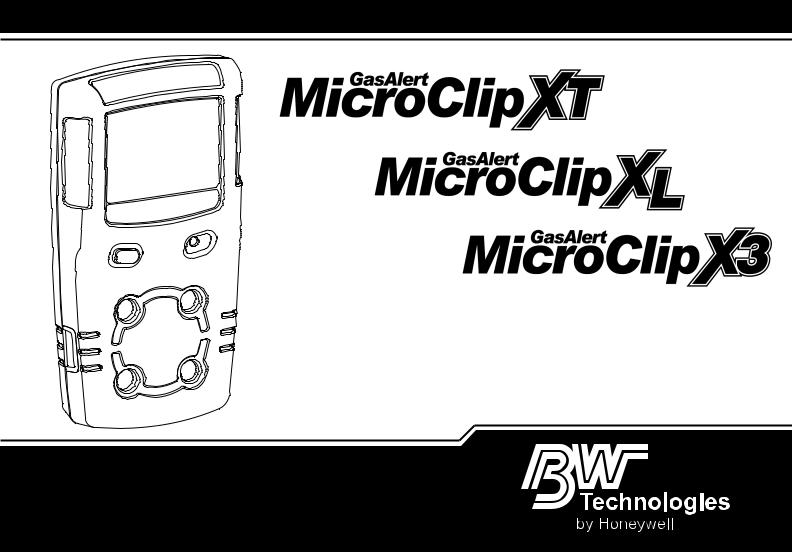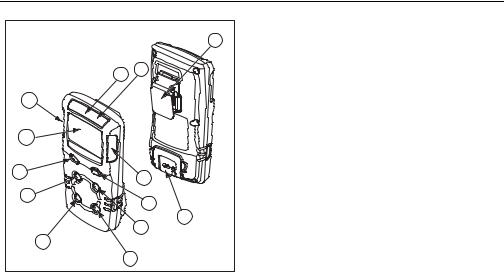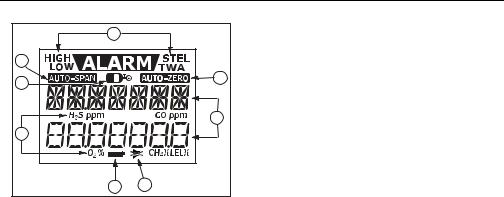Honeywell BW MicroClip X3 Operating Manual

1, 2, 3, and 4-Gas Detector
Operator’s Manual
Limited Warranty and Limitation Liability
BW Technologies LP (BW) warrants the product to be free from defects in material and workmanship under normal use and service for a period of two years, beginning on the date of shipment to the buyer. This warranty extends only to the sale of new and unused products to the original buyer. BW’s warranty obligation is limited, at BW’s option, to refund of the purchase price, repair or replacement of a defective product that is returned to a BW authorized service center within the warranty period. In no event shall BW’s liability hereunder exceed the purchase price actually paid by the buyer for the Product.
This warranty does not include:
a)fuses, disposable batteries or the routine replacement of parts due to the normal wear and tear of the product arising from use;
b)any product which in BW’s opinion, has been misused, altered, neglected or damaged, by accident or abnormal conditions of operation, handling or use;
c)any damage or defects attributable to repair of the product by any person other than an authorized dealer, or the installation of unapproved parts on the product; or
The obligations set forth in this warranty are conditional on:
a)proper storage, installation, calibration, use, maintenance and compliance with the product manual instructions and any other applicable recommendations of BW;
b)the buyer promptly notifying BW of any defect and, if required, promptly making the product available for correction. No goods shall be returned to BW until receipt by the buyer of shipping instructions from BW; and
c)the right of BW to require that the buyer provide proof of purchase such as the original invoice, bill of sale or packing slip to establish that the
product is within the warranty period.
THE BUYER AGREES THAT THIS WARRANTY IS THE BUYER’S SOLE AND EXCLUSIVE REMEDY AND IS IN LIEU OF ALL OTHER WARRANTIES, EXPRESS OR IMPLIED, INCLUDING BUT NOT LIMITED TO ANY IMPLIED WARRANTY OF MERCHANTABILITY OR FITNESS FOR A PARTICULAR PURPOSE. BW SHALL NOT BE LIABLE FOR ANY
SPECIAL, INDIRECT, INCIDENTAL, OR BASED ON CONTRACT, TORT OR RELIANCE OR ANY OTHER THEORY.
Since some countries or states do not allow limitation of the term of an implied warranty, or exclusion or limitation of incidental or consequential damages, the limitations and exclusions of this warranty may not apply to every buyer. If any provision of this warranty is held invalid or unenforceable by a court of competent jurisdiction, such holding will not affect the validity or enforceability of any other provision.
Contacting BW Technologies by Honeywell
USA: 1-888-749-8878 |
Canada: 1-800-663-4164 |
Europe: +44(0) 1295 700300 |
Other countries: +1-403-248-9226 |
Email us at: detectgas@honeywell.com
Visit BW Technologies by Honeywell’s website at: www.honeywellanalytics.com

GasAlertMicroClip
Introduction
Introduction
The operator’s manual provides basic information for the GasAlertMicroClip XT, XL and X3. For complete operating instructions, refer to the GasAlertMicroClip Technical Reference Guide provided on the CD-ROM. The GasAlertMicroClip (“the detector”) warns of hazardous gas at levels above user-defined alarm setpoints. The detector is a personal safety device. It is your responsibility to respond properly to the alarm.
Note
The detector is shipped with English as the default displayed language. Additional languages provided are Portuguese, Spanish, German, and French. The screens for the additional languages are displayed on the detector and in the corresponding operator’s manuals.
What’s In a Box
Detector Calibration Cap
Battery Charging Adapter Documentation Kit
GasAlertMicroClip
Zeroing the Sensors
To zero the sensors, refer to steps #1-3 in Calibration on page 7.
ec Warning
This instrument contains a lithium polymer battery. Dispose of lithium cells immediately. Do not disassemble and do not dispose of in fire. Do not mix with the solid waste stream. Spent batteries should be disposed of by a qualified recycler or hazardous materials handler.
ec Avertissement
Cet appareil contient une batterie au lithium polymère. Mettez immédiatement au rebut les piles au lithium usagées. Veillez à ne jamais les démonter ou les jeter au feu. Ne les mélangez pas aux autres déchets solides. Les piles usagées doivent être éliminées par un centre de recyclage agréé ou par un centre de traitement de matières dangereuses.
1

GasAlertMicroClip
Operator’s Manual
XT, XL and X3 Safety Information - Read First
Use the detector only as specified in this manual and the reference guide, otherwise the protection provided by the detector may be impaired. Read the following cautions before using the detector.
aCautions
•Warning: Substitution of components may impair Intrinsic Safety.
•Caution: For safety reasons, this equipment must be operated and serviced by qualified personnel only. Read and understand the user manual completely before operating or servicing.
•Charge the detector before first time use. BW recommends the detector be charged after every workday.
•Before using the detector, refer to Sensor Poisons and Contaminants.
•Calibrate the detector before first-time use and then on a regular schedule, depending on use and sensor exposure to poisons and contaminants. BW recommends calibrating at least once every 180 days (6 months).
•The combustible sensor is factory calibrated to 50% LEL methane. If monitoring a different combustible gas
in the %LEL range, calibrate the sensor using the appropriate gas.
•Only the combustible gas detection portion of this instrument has been assessed for performance by CSA International.
•Calibrate only in a safe area that is free of hazardous gas and in an atmosphere of 20.9% oxygen.
•It is recommended that the combustible sensor be checked with a known concentration of calibration gas after any exposure to contaminants/poisons such as, sulfur compounds, silicon vapors, halogenated compounds, etc.
•BW recommends to bump test the sensors before each day’s use to confirm their ability to respond to gas by exposing the detector to a gas concentration that exceeds the alarm setpoints. Manually verify that the audible and visual alarms are activated. Calibrate if the readings are not within the specified limits.
•Caution: High off-scale readings may indicate an explosive concentration.
•Any rapid up scaling reading followed by a declining or erratic reading may indicate a gas concentration beyond the upper scale limit, which can be hazardous.
•Extended exposure of the GasAlertMicroClip to certain concentrations of combustible gases and air may stress a detector element that can seriously affect its
2

GasAlertMicroClip
XT, XL et X3 Informations de sécurité – À lire au préalable
performance. If an alarm occurs due to a high concentration of combustible gases, calibrate the detector. If necessary, replace the sensor.
•Protect the combustible sensor from exposure to lead compounds, silicones, and chlorinated hydrocarbons.
•Sensor exposure to certain organic vapors (such as leaded gasoline and halogenated hydrocarbons) may temporarily inhibit sensor performance. After exposure, a bump test or calibration is recommended.
•For use only in potentially explosive atmospheres where oxygen concentrations do not exceed 20.9% (v/v).
•Products may contain materials that are regulated for transportation under domestic and international dangerous goods regulations. Return product in compliance with appropriate dangerous goods regulations. Contact freight carrier for further instructions.
XT, XL et X3 Informations de sécurité – À lire au préalable
Respectez rigoureusement les instructions d'utilisation figurant dans ce manuel ainsi que dans le guide technique sous peine de compromettre la protection offerte par le détecteur. Lisez les mises en garde suivantes avant d’utiliser le détecteur.
a Mises en garde
•Avertissement : Le remplacement d'un composant de l'appareil peut compromettre la sécurité intrinsèque du détecteur.
•Mise en garde : Pour des raisons de sécurité, cet appareil doit être utilisé et entretenu par du personnel qualifié uniquement.
Lisez attentivement le manuel avant d’utiliser l’appareil ou d'en assurer l'entretien et assurez-vous d'en avoir bien compris les instructions.
•Chargez le détecteur avant sa première utilisation. BW recommande de recharger le détecteur après chaque journée d’utilisation.
•Avant toute utilisation du détecteur, reportez-vous à la section .
•Étalonnez le détecteur avant sa première utilisation, puis de manière régulière, en fonction de l’utilisation et de l’exposition du capteur aux poisons et autres contaminants. BW recommande d'effectuer un étalonnage au moins une fois tous les 180 jours
(6 mois).
•Le capteur de gaz combustibles est étalonné en usine au méthane, à une concentration de 50 % de la LIE. Si le contrôle porte sur un autre gaz combustible dans la plage de % LIE, étalonnez le capteur en utilisant le gaz approprié.
3

GasAlertMicroClip
Operator’s Manual
•Sur cet appareil, seule la détection de gaz combustibles a fait l’objet d’une évaluation des performances par CSA International.
•Veillez à effectuer l'étalonnage dans une zone sûre, exempte de gaz dangereux, et dans une atmosphère contenant 20,9 % d'oxygène.
•Si le capteur de gaz combustibles a été exposé à des contaminants/poisons (composés de soufre, vapeurs de silicium, produits halogénés, etc.), il est conseillé de vérifier son bon fonctionnement en le mettant en présence d'une concentration connue d'un gaz.
•Avant chaque utilisation quotidienne, BW recommande d’effectuer un test fonctionnel des capteurs afin de vérifier qu’ils réagissent bien aux gaz présents, en exposant le détecteur à une concentration de gaz supérieure aux seuils d’alarme. Vérifiez manuellement que les alarmes sonore et visuelle sont activées. Étalonnez l’appareil si les relevés ne sont pas conformes aux limites spécifiées.
•Mise en garde : Des relevés élevés hors échelle peuvent indiquer la présence d’une concentration explosive.
•Toute mesure en rapide augmentation suivie d’une diminution ou d’une mesure fantaisiste peut indiquer une concentration de gaz au-delà de la limite d’échelle supérieure, risquant donc d’être dangereuse.
•Une exposition prolongée du GasAlertMicroClip XT à
certaines concentrations de gaz combustibles et dans certaines atmosphères peut nuire à l'élément de détection et altérer gravement ses performances. Étalonnez le détecteur après toute exposition à des concentrations élevées de gaz combustibles ayant déclenché son alarme. Si nécessaire, remplacez le capteur.
•Protégez le capteur de gaz combustibles contre toute exposition aux composés de plomb, aux silicones et aux hydrocarbures chlorés.
•L'exposition du capteur à certaines vapeurs organiques (comme l'essence au plomb ou les hydrocarbures halogénés) peut altérer temporairement son bon fonctionnement. Il est recommandé de procéder à un test fonctionnel ou à un étalonnage après toute exposition.
•Cet appareil est destiné uniquement à une utilisation dans des atmosphères potentiellement explosives, dans lesquelles la concentration d’oxygène ne dépasse pas 20,9 % (v/v).
•Les produits peuvent contenir des matériaux qui sont réglementés pour le transport en vertu des règlements nationaux et internationaux de marchandises dangereuses. Retourner le produit conformément à la réglementation sur les marchandises dangereuses appropriées. Contactez transporteur de fret pour plus d'instructions
4

GasAlertMicroClip
Parts of the GasAlertMicroClip
Parts of the GasAlertMicroClip
|
|
3 |
|
1 |
2 |
|
|
|
2 |
|
|
11 |
|
|
10 |
|
2 |
|
|
|
9 |
|
5 |
|
|
|
|
|
4 |
|
|
6 |
|
8 |
|
|
|
7 |
Item |
Description |
1 |
IntelliFlash |
|
|
2 |
Visual alarm indicators (LEDs) |
|
|
3 |
Alligator clip |
|
|
4 |
Charging connector / IR interface |
|
|
5 |
Pushbutton |
|
|
6 |
Carbon monoxide (CO) sensor |
|
|
7 |
Hydrogen sulfide (H2S) sensor |
8 |
Oxygen (O2) sensor |
9 |
Combustible (LEL) sensor |
|
|
10 |
Audible alarm |
|
|
11 |
Liquid crystal display (LCD) |
|
|
5

GasAlertMicroClip
Operator’s Manual
Display Elements
1 |
|
8 |
|
7 |
2 |
|
|
|
3 |
6 |
|
5 |
4 |
Item |
Description |
|
|
1 |
Alarm condition |
|
|
2 |
Automatically zero sensor |
|
|
3 |
Numeric value |
|
|
4 |
Stealth mode |
|
|
5 |
Battery life indicator |
|
|
6 |
Gas identifier bars |
|
|
7 |
Gas cylinder |
|
|
8 |
Automatically span sensor |
|
|
6

GasAlertMicroClip
Pushbuttons
Pushbuttons
Pushbutton |
Description |
|
• To activate the detector, press C. |
|
• To deactivate the detector, press and hold C until the OFF countdown is complete and the LCD deactivates. |
|
• To view the TWA, STEL, and MAX (maximum) readings, press C twice. To clear the TWA, STEL, and MAX |
|
readings, press C when the LCD displays RESET. |
C |
• To initiate calibration, deactivate the detector. Press and hold C while the detector performs the OFF |
countdown. Continue holding C while the LCD briefly deactivates and then begins the CAL countdown. |
|
|
Release C when the CAL countdown is complete. |
|
• To activate the backlight while in normal operation, press C. |
|
• To acknowledge latched alarms, press C. |
|
• To acknowledge a low alarm and disable the audible alarm, press C(if the Low Alarm Acknowledge option |
|
is enabled). |
|
|
7

GasAlertMicroClip
Operator’s Manual
Sensor Poisons and Contaminants |
• |
Alcohol based cleaners |
||
Several cleaners, solvents, and lubricants can contaminate and |
• |
Hand sanitizers |
||
• |
Anionic detergents |
|||
cause permanent damage to sensors. Before using cleaners, |
||||
• Methanol (fuels and antifreezes) |
||||
solvents, and lubricants in close proximity to the detector |
||||
|
Silicones |
|||
sensors, read the following caution and table. |
|
|||
• Silicone cleaners and protectants |
||||
|
|
|||
|
a Caution |
• Silicone based adhesives, sealants, and gels |
||
|
• |
Hand/body and medicinal creams containing silicone |
||
Use only the following BW Technologies by Honeywell |
• |
Tissues containing silicone |
||
recommended products and procedures: |
• |
Mold releasing agents |
||
|
|
|||
• |
Use water based cleaners. |
• |
Polishes |
|
• Use non-alcohol based cleaners. |
|
Aerosols |
||
• Clean the exterior with a soft, damp cloth. |
• Bug repellents and sprays |
|||
• |
Lubricants |
|||
• Do not use soaps, polishes, or solvents. |
||||
• |
Rust inhibitors |
|||
Below are common products to avoid using around sensors. |
||||
• |
Window cleaners |
|||
|
Cleaners and Lubricants |
|||
|
|
|
||
• |
Brake cleaners |
|
|
|
• |
Lubricants |
|
|
|
• |
Rust inhibitors |
|
|
|
• Window and glass cleaners |
|
|
||
• |
Dishsoaps |
|
|
|
• |
Citrus based cleaners |
|
|
|
8
